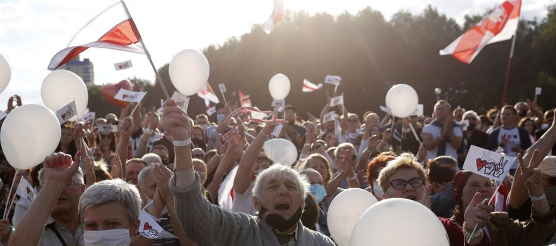
Belarus is looking like a new Cold War battleground since protests broke out following the disputed election of Aleksandr Lukashenko on Sunday, August 9th.
Lukashenko won the election with 80 percent of the vote, though his opponent, Svetlana Tikhanovskaya, who garnered 10 percent of the vote, stated that she had won.
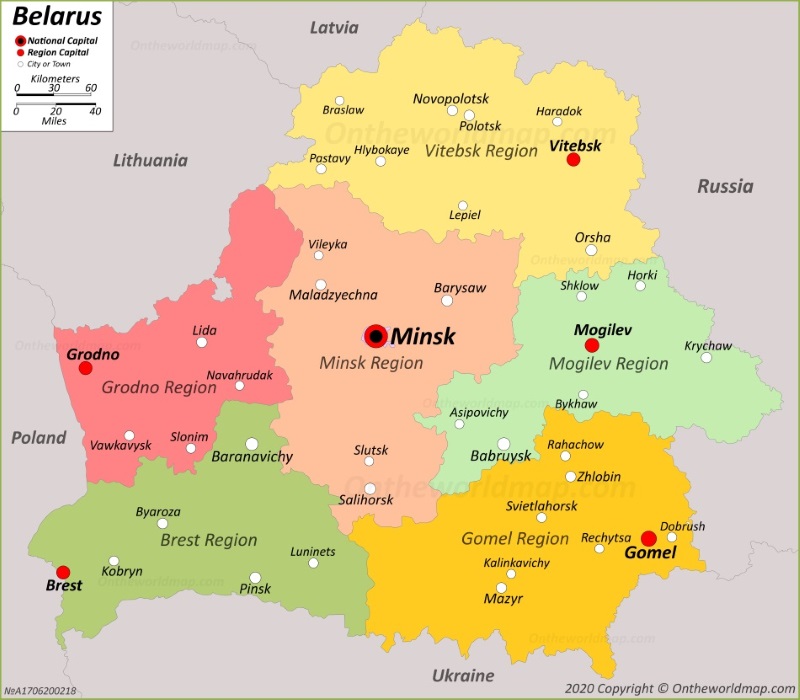
Thousands of protesters supporting Tikhanovskaya in the capital of Minsk and other regional cities such as Brest, Grodno and Mogilev were subsequently detained by the authorities and others picked up randomly on the streets, much like what recently happened to protesters in Portland, Oregon. Women wearing white clothes with flowers in hand have sought to display their solidarity with political prisoners.
One protester died after a confrontation with security forces when an unidentified explosive device allegedly detonated in his hands, indicating, if the latter is true, that not all of the protests were peaceful.[1]
Lukashenko, for his part, has been defiant, vowing that “we will not allow the country to be torn apart. There will be no Maidan no matter how much anyone wants one.”[2] The latter was a reference to protests that brought to power a pro-Western regime in Ukraine in February 2014 through a coup d’état that provoked a civil war when the eastern provinces decided to separate.[3]
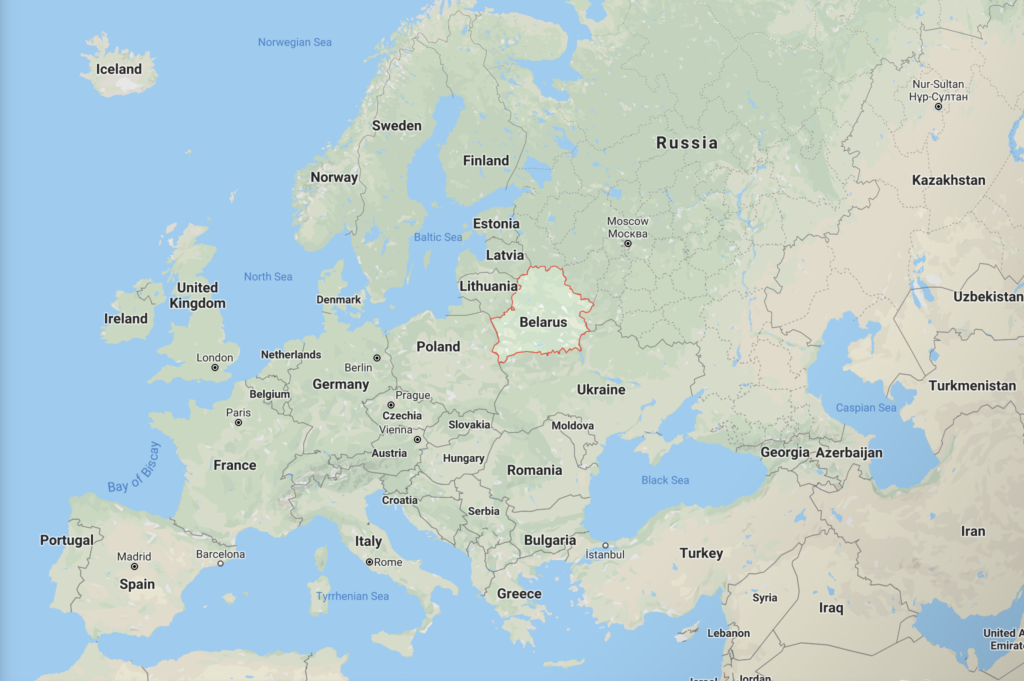
Another comparison is with previous Western-backed “color revolutions” in Eastern Europe that resulted in the overthrow or attempted overthrow of Soviet-style leaders who were antagonistic to the expansion of the North Atlantic Treaty Organization (NATO). Lukashenko survived one of these in 2006 when the Bush administration labeled him as the “last dictator of Europe” and part of the Axis of Evil.[4]
In 2004, President George W. Bush signed the Belarus Democracy Act, introduced by Congressman Christopher Smith (R-NJ), which provided millions of dollars to opposition groups in Belarus through the National Endowment for Democracy (NED)—an organization established in the 1980s to operationalize aspects of CIA covert activity. The NED sponsored grants to train youth activists, establish radio and television stations and fund anti-government NGOs while pushing for European integration at the expense of Russia.[5]
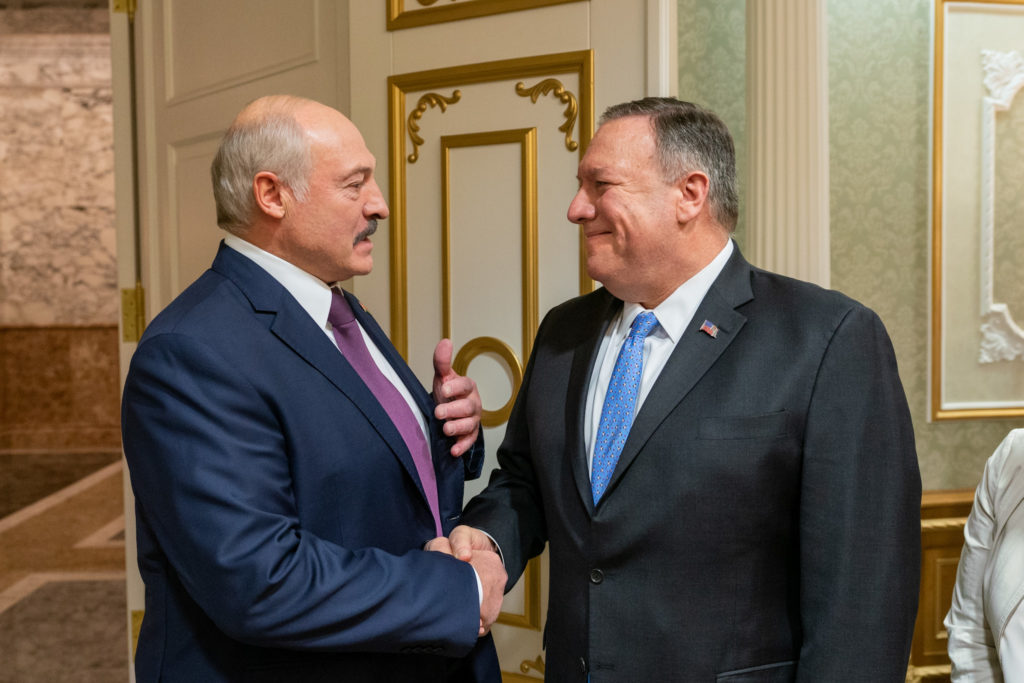
A group of counterinsurgency specialists with experience in political subversion were sent to Belarus at that time. They included Peter Ackerman, a protégé of Gene Sharp, a Cold War defense intellectual who wrote the manual on how to overthrow authoritarian regimes.[6] Secretary of State Mike Pompeo offered a hint that the U.S. was supporting this latest wave of protests when he conveyed America’s “deep concern about the conduct of Sunday’s election,” which he called “not free and fair.” Pompeo further urged Lukashenko to refrain from force and to release those wrongfully detained, and said that the people of Belarus should be granted “the freedom that they are demanding.”[7]

On July 27, just two weeks before the election, the U.S. appointed a new chargé d’affaires in the American embassy in Minsk, Jeffrey Giauque, who became deputy chief of mission, a traditional post for resident CIA.[8] Giauque previously served in Turkmenistan, when the U.S. was trying to revive an oil pipeline that would bypass Russia and forge closer ties with Garbanguly Berdmuhamedor, one of the world’s most oppressive leaders. Giauque has also been posted in Croatia and Serbia at a time the U.S. was trying to shore up the post-Slobodan Milosevic order following a U.S.-backed color revolution.[9]
In 2018-2019, the NED spent almost three million dollars in Belarus according to its website and had at least 34 active projects.
A lot of the funding was directed toward training youth activists in political organizing, strengthening NGOs and financing independent anti-Lukashenko media, which played a pivotal role in trying to stir up opposition and protests against him.[10] The NED has also set out to publicize human rights abuses as a means of undermining Lukashenko’s legitimacy.[11]
An important precedent had been established twenty years earlier in Serbia, where the NED financed and trained the youth leaders of the Otpor resistance movement, which helped unseat Milosevic, a socialist like Lukashenko. Milosevic was replaced by Vojislav Kostunica, who pushed a privatization agenda and froze the wages of working people under the instructions of the International Monetary Fund (IMF).[12]

The Washington Post at the time reported about “an extraordinary U.S. effort to unseat a foreign head of state, not through covert action of the kind the CIA once employed in such places as Iran and Guatemala, but by modern election campaign techniques.”[13]
In October 1999, Doug Schoen, a Democratic Party campaign consultant who had helped reelect Boris Yeltsin in Russia in 1996, gave a closed-door briefing hosted by the Washington-based National Democratic Institute (NDI) to leaders of Serbia’s previously fractious opposition. In Budapest’s Marriot hotel, Schoen summarized the results of a polling survey conducted by his firm, Penn, Schoen & Berland Associates, which pointed to Milosevic’s electoral vulnerability.
U.S.-funded consultants went on to play a crucial role behind the scenes in virtually every facet of the anti-Milosevic drive, running tracking polls, training thousands of opposition activists and helping to organize a vitally important parallel vote count. U.S. taxpayers paid for 5,000 cans of spray paint used by student activists to scrawl anti-Milosevic graffiti on walls across Serbia, and 2.5 million stickers funded by USAID with the slogan “He’s Finished (Gotov Je!)” which became the revolution’s catchphrase.[14]

On August 7, the Lukashenko regime detained Vitali Shkliarov, a Belaroussian-born U.S. citizen married to a U.S. diplomat who worked as a campaign aide to Barack Obama in 2012 and Bernie Sanders in 2016. His background would suggest that he might be playing a similar role as Schoen in Serbia, or is in some way involved in efforts to unseat Lukashenko. Shkliarov serves as a fellow at Harvard University and the inside the beltway Foreign Policy Research Institute and, in 2018, worked as a campaign aide for an anti-Putin candidate, Ksenia Sobchak, in Russia. In Belarus, Shkliarov runs a Telegram channel of the kind that is funded by the NED, which he has used as a platform to denounce Lukashenko for his “populism and brute force.”[15]
In July, a group of Russian mercenaries were arrested and accused of trying to oust Lukashenko.[16] There is speculation as to whether they were part of a black ops operation organized either by Lukashenko or the Ukrainian secret service, whose intention was to make it appear that Russia was trying to destabilize Belarus. The Russian mercenaries testified that they had been told they were being recruited to provide security in overseas countries (Sudan and Venezuela) but that their flight was delayed deliberately and that they were arrested in the middle of the night at the hotel, near Lukashenko’s residence, where they were resting. No weapons were found on them or evidence of covert plans.[17]
The United States, with EU backing, is trying to use the current crisis in Belarus to score a victory over Vladimir Putin in the new Cold War.
Putin views Belarus as a buffer zone between Russia and the West and has helped support Lukashenko over the years with loans and energy subsidies.[18] The two countries have carried out joint military exercises, and Putin has long dreamed of merging them. Belarus is located on Russia’s western border and has historically been a key channel for invading Russia.
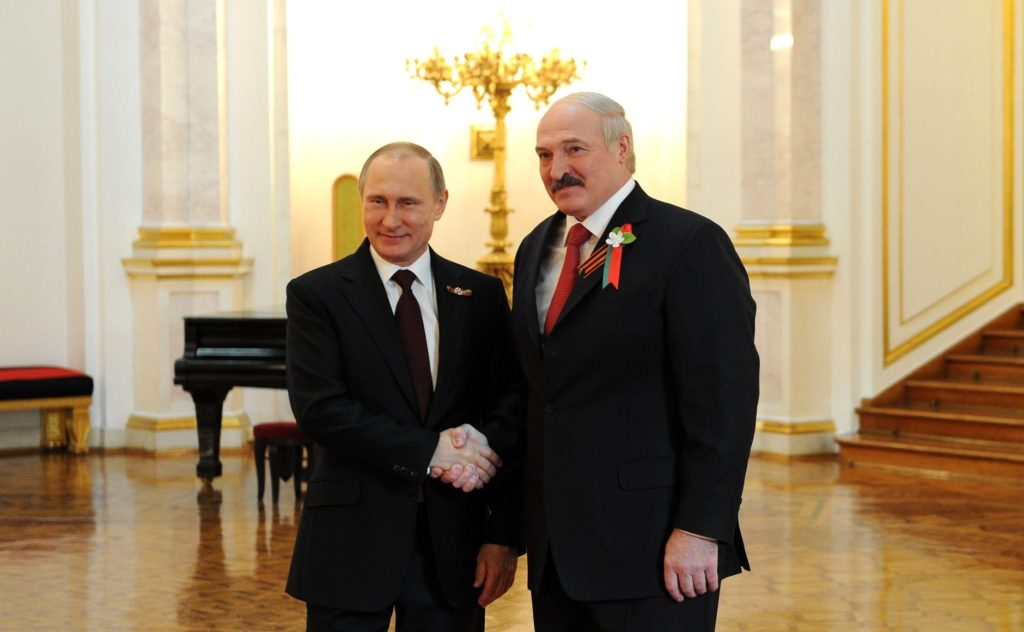
In a congratulatory note on August 9, Putin described Russia and Belarus as “brotherly nations” while restating his desire to move ahead on the stalled union.[19] Furthermore, on August 15, Putin affirmed an agreement to provide military assistance to uphold Belarus’s security. Lukashenko stated that the moment fits the agreement and pointed to the buildup of the military component in neighboring Poland and Lithuania, where NATO military exercises are held.[20]
Lukashenko has to generally navigate an extraordinarily difficult situation with the U.S., NATO, and EU breathing down his neck on one flank, and Russian oligarchs wanting to maintain a buffer state and privatize Belarus on the other.
The Russian orthodox church also wants to open churches in the most secular state in Europe. Without oil reserves, Lukashenko is trying to hold on as best as he can, and naturally is turning to Russia for protection.
A model socialist state?
Lukashenko first came to power in 1994. Serving in his youth in the Young Communist League and Red Army and then as director of a collective farm, he gained a reputation as a populist, anti-corruption crusader after his election to the Supreme Council of Belarus in 1990.
Since 1994, Lukashenko has built a base of popular support opposing Western economic shock therapy policies which devastated Russia’s economy under Boris Yeltsin.
Lukashendo also supported state ownership of key industries including the banking sector which he nationalized after the currency collapsed.[21]
These policies and other populist measures kept both the unemployment rate near zero, despite the pressure caused by U.S. sanctions, and poverty rates well below the European and Central Asian averages. The country’s Gini coefficient, measuring inequality, was also better than any EU nation, including Denmark. Health care and all education, including higher education, is free.[22] A Western diplomat stated “what is laudable is that they don’t want anyone to slip through the social safety net.”[23] In 2006, Venezuela’s Socialist President Hugo Chavez called Belarus under Lukashenko’s leadership “a model socialist state.”[24]
Two different national flags: two competing visions
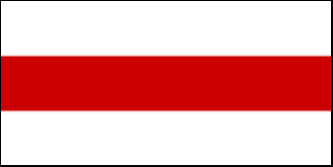
Notably, protesters are waving the white-red-white flag of the short-lived People’s Republic of Belarus, which opposed Bolshevik rule following the Russian revolution in 1917, and was again adopted briefly after the fall of the Soviet Union. During World War II, the flag was used by Belarussian organizations collaborating with the Nazis.[25]

In 1995, Belarus’s voters approved a red-green flag, which resembles the old Soviet flag minus the hammer and sickle. Today, statues of Lenin and other Bolshevik heroes still dominate many of Belarus’s cities.
Lukashenko’s defiance to follow other pro-Western pressures was exemplified when he allowed Saddam Hussein to acquire a Belarussian passport prior to the 2003 Operation Iraqi Freedom.[27] In a keynote address at an anti-Lukashenko conference at the American Enterprise Institute in November 2002, Senator John McCain stated that Belarus was a security threat to the U.S. because they contributed to the death of American soldiers in Iraq [by selling arms to Saddam and training Iraqi military units]; “a friend of our enemy [Saddam] is our enemy.”[28]
Lukashenko has more recently forged good relations with Syrian leader Bashar al-Assad, who congratulated him on his recent election victory, as did China’s Xi Jinping. Lukashenko futher condemned the U.S. aggression in Libya in 2011, saying that the manner in which Muammar Qaddafi was humiliated and tortured to death was “worse than what the Nazis once did.”[29]
An independent foreign and domestic policy, coupled with a strong economic safety net and a rejection of neoliberal policies, are among the key factors that make countries prime target for U.S.-sponsored regime change, as has been operationalized against countries like Cuba, Nicaragua, Venezuela and North Korea, to name a few.[26]
Notwithstanding all of the above, prior to the recent outbreak of protests in August, the U.S. had been warming up to Lukashenko. In May 2020, after a visit by Mike Pompeo, he signed a deal to import U.S. oil from the U.S. energy trader United Energy Trading.[30] The Washington Post reported that this deal was “more than just an energy deal, it was a message to Moscow. One of Russia’s most reliable allies was testing its ties with the West.”[31] The U.S. for its part sensed an opportunity to score a point over Moscow; a senior Trump administration official stated: “This is an era of great power competition and an opportunity to compete for influence.”[32]

Biased media coverage
The American media’s coverage of the crisis in Belarus has predictably been biased. Reuters, for example, titled an article “Lithuania says Russia is using Belarus crisis to try to draw It closer Into its orbit.”[33] Omitted is the fact that the U.S. is also trying to use the crisis to its own advantage; Belarus is distant from its shores and relatively insignificant to its national security. CNN’s headline focused on how other authoritarian leaders, most notably Putin and Chinese Premier Xi Jinping, are rallying behind Lukashenko, while The New York Times editorialized that “even those prone to paranoid conspiracy theories about the West have questioned Mr. Lukashenko’s fitness to govern.”[34]
For years, Lukashenko has been demonized in Western media as a caricature of Soviet misrule and eastern despotism. While some of the criticisms may be accurate, a more nuanced picture could be provided, which would recognize the economic stability that Belarus has achieved for many years. Under his direction. Lukashenko has effectively resisted shock-therapy policies, rapid privatization and deregulation, and avoided cutbacks in state services pushed by the U.S.—economic policies which devastated Russia and other post-Soviet states in the 1990s.
Further, The New York Times and other outlets have made it seem like Lukashenko is poised to fall, when the army has remained loyal to him. Moreover, many Belarussians, especially the older generations, continue to support him because of his economic program. Most of all, they want stability, have strong historical links to Russia and believe that he is the best to deliver both stability and economic benefits from Moscow.
The large number of police injured on the first day (39 police compared to 50 protesters) combined with the death of a protester from premature detonation of his own explosive device[35] indicates that there were violent provocateurs within the crowds. Vladimir Dzhabarov, 1st Deputy Chairman of the International Affairs Committee of the Federal Council of the Federal Assembly of Russia, stated at an online press conference on August 11:
“The fact that the protests began right after the polling stations were closed, indicates that they had been pre-prepared, that the actions had been orchestrated. Because it is impossible to prepare the protests that happened within one or two hours specifically prepared people took to the streets. I am not saying that only those who are trying to destabilize the situation in Belarus are now participating in the protests. It is possible that other dissatisfied people were there, that there were some grudges. But there is no doubt that the instigators intended to destabilize the situation in Belarus.”
Dzhabarov added that, “while the situation looked like the Maidan protests in Ukraine, Lukashenko was not Yanukovych [pro-Russian Ukrainian leader deposed in 2014 Maidan coup] who flew to Kharkov and then to Crimea and then to Rostov. Lukashenko will not leave Belarus and will defend the authority his people have given him.”[36]
Misguiding Illusions
In the last decade, the American left has often been misguided in supporting protest movements around the world. While thinking such movements were liberal and pro-democratic, they were actually led by Islamic fundamentalists or neoliberals who would allow their countries to be destabilized and their assets to be sold off.
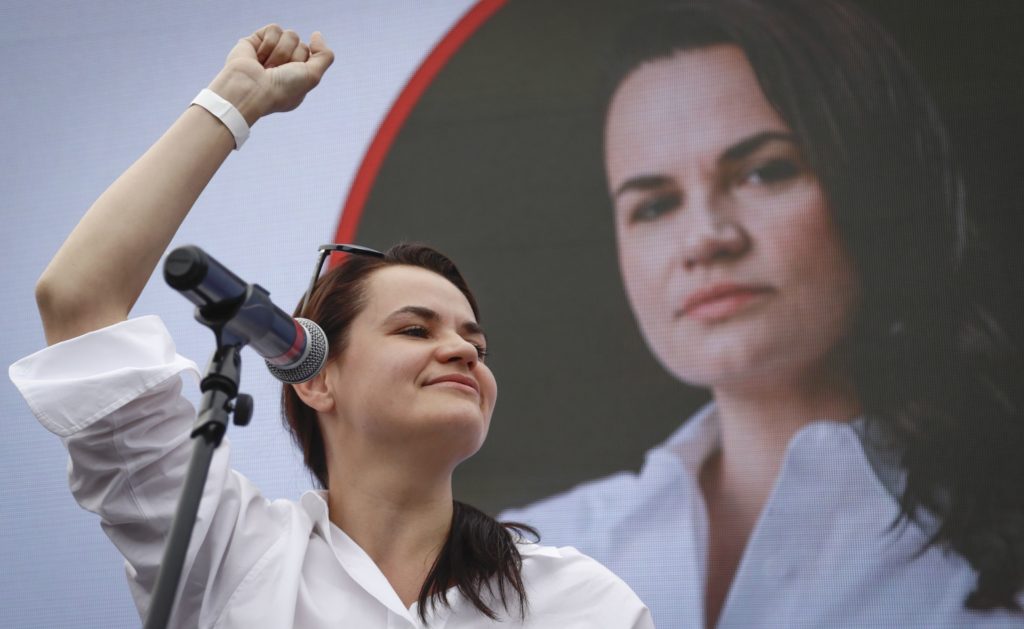
Lukashenko’s rival in the case of Belarus, Ms. Tikhanovskaya, took to wearing white blouses and white plastic bands on her wrists all in a nod to political groundswells in other countries that used unifying colors such as the Orange Revolution in neighboring Ukraine in 2004-2005. Her platform was very vague, demanding the release of political prisoners only and new elections, but no new vision for economic transformation, a key concern Belarussians have historically prioritized.[37]
Only 37, Ms. Tikhanovskaya had been a teacher and homemaker who became known after her husband, a popular video blogger, was arrested. In one campaign stunt, she and her entourage attended a pro-Lukashenko rally, where two DJs on cue played the song by the Soviet rock group Kino, “I Want Changes!” which was a popular protest anthem in the Soviet Union.[38]
Tikhanovskaya has been backed by two other oppositionists, Viktar Babaryka and Valery Tsepkalo, who are wealthy champions of private property and the free market.[39] After the protests broke out, she fled to Lithuania, whose poor human rights record has been overlooked because its government is pro-West and joined NATO in April 2004.[40]
The danger is that Tikhanovskaya would provide a fake-progressive front for the reconstruction of Belarus’s economy along neoliberal lines and enable further NATO expansion on Russia’s border.
One of the NED-sponsored pro-democracy activists, Franak Viachorka, co-writer of an NED-sponsored feature film based on his life as a political dissident, said that he wants a “free, democratic European Belarus providing anyone can work, make an [honest living] and earn money.”[41] These comments suggest the goal of alignment with the U.S. and EU, over Russia, includes the transformation of Belarus’ economy into a capitalist one; an economy providing privileged youth like himself—Viachorka is only 26 and the son of a prominent opposition party leader—to make money while the social safety net is destroyed.
Dzhabarov duly noted that Tikhanovskaya’s credibility would be enhanced if she had gotten more of the vote. He says that “she represents no one, no one will [in the end] fight for her.”[42] It remains to be seen if Dzhabarov is correct. What is clear, however, is the need to be cautious about the protests in Belarus, which could easily be manipulated by nefarious outside forces and lead to dangerous outcomes.

[1] Ivan Nechepurenko and Andrew Higgins, “Clashes Convulse Belarus’s Capital after President Claims Landslide,” The New York Times, August 11, 2020.
[2] Nechepurenko and Higgins, “Clashes Convulse Belarus’s Capital after President Claims Landslide.”
[3] See Richard Sakwa, Frontline Ukraine: Crisis in the Borderland (London: I.B. Tauris, 2016).
[4] “Protests in Belarus: The Upsurge of a New Color Revolution?” “Rice: Belarus is Dictatorship,” CNN, April 20, 2005, https://www.cnn.com/2005/WORLD/europe/04/20/rice.belarus/. Secretary of State Condoleezza Rice stated, “if it brings about democratic progress, why is it a bad thing for people to throw off the yoke of tyranny and decide they want to control their own futures?”
[5] “Belarus Alert,” September 25, 2005; “President Bush Signs Belarus Democracy Act on Heels of Rigged Elections and Referendum,” October 21, 2004, https://www.csce.gov/international-impact/press-and-media/press-releases/president-bush-signs-belarus-democracy-act-heels
[6] “Belarus Alert,” September 25, 2005; Marcie Smith, “Getting Gene Sharp Wrong,” Jacobin, December 2, 2019. Ackerman had earned the second highest Wall Street salary in history in 1988 ($165 million) before taking up a position as Director of Freedom House. Others who went to Belarus included Boyden Gray, an old crony of President George H.W. Bush from the R.J. Reynolds tobacco dynasty, and Glyn T. Dayen, the assistant secretary of state for democracy, human rights and labor, who had coordinated fabrication of intelligence in the run-up to the Iraq war as deputy chief of mission at the U.S. embassy in London.
[7] Nechepurenko and Higgins, “Clashes Convulse Belarus’s Capital after President Claims Landslide”; “Belarus Election: Police Use Live Fire on Protestors in Brest,” BBC News, August 13, 2020, https://www.bbc.com/news/world-europe-53748748
[8] See https://by.usembassy.gov/please-welcome-the-new-charge-daffaires-jeffrey-giauque/
[9] https://by.usembassy.gov/our-relationship/our-ambassador/. On Turkmenistan, see Sinead Baker, “Meet the Dictator Who Rules Secretive Turkmenistan, who portrays himself as an action hero and shows off by lifting gold bars in parliament,” Business Insider, March 14, 2020, https://www.businessinsider.com/turkmenistan-leader-gurbanguly-berdymukhamedov-biography-2020-1; Darren Goode, “Pipeline to Bypass Russia Pushed,” Politico, April 17, 2014, https://www.politico.com/story/2014/04/gas-pipeline-bypass-russia-105786
[10] National Endowment for Democracy, 2019, Belarus, https://www.ned.org/region/central-and-eastern-europe/belarus-2019/
[11] https://www.ned.org/region/central-and-eastern-europe/belarus-2018/
[12] Michael Dobbs, “U.S. Advice Guided Milosevic Opposition,” The Washington Post, December 11, 2000; Michael Chossudovsky, “Economic Terrorism,” in Hidden Agenda: U.S./NATO Takeover of Yugoslavia, ed. John Catalinotto and Sara Flounders (New York: International Action Center, 2002), 286.
[13] Michael Dobbs, “U.S. Advice Guided Milosevic Opposition,” The Washington Post, December 11, 2000. Peter Ackerman, who promoted regime change in Belarus, helped produce a PBS documentary on the overthrow of Milosevic, Bringing Down a Dictator.
[14] Dobbs, “U.S. Advice Guided Milosevic Opposition”; William F. Engdahl, Manifest Destiny: Democracy as Cognitive Dissonance (Mine Books, 2018), 121-132. A symbol of the clenched fist was adopted by Harvard University students in the protests of 1968/69. Engdahl writes that the Pentagon had become very sophisticated in learning to conceal its coup d’états under the guise of nonviolence.
[15] Christopher Miller, “A Former Bernie Sanders Campaign Staffer Is Stuck in a Belarus Jail Cell, Charged With Disrupting the Peace,” BuzzFeed News, August 7, 2020, https://www.buzzfeednews.com/article/christopherm51/us-campaign-aide-jailed-belarus. Shkliarov claimed that he was visiting Belarus on a diplomatic passport to see his mother who was sick with cancer. He has also worked as a political consultant in Georgia and Ukraine.
[16] Mitch Prothero, “The arrest of 33 Russian mercenaries amid election chaos in Belarus is testing Putin’s patience,” Business Insider, August 10, 2020, https://www.businessinsider.com/belarus-lukashenko-arrested-33-russian-mercenaries-putin-2020-8
[17] “Russian Mercenaries in Belarus: All You Need to Know,” The Moscow Times, July 31, 2020, https://www.themoscowtimes.com/2020/07/30/russian-mercenaries-in-belarus-all-you-need-to-know-a71020.
[18] Andrei Makhovsky, “Pompeo visits Belarus as Minsk’s ties with Moscow fray,” Reuters, February 1, 2020, https://www.reuters.com/article/us-belarus-usa-pompeo/pompeo-visits-belarus-as-minsks-ties-with-moscow-fray-idUSKBN1ZV3IO.
[19] Ibid. Foreign Affairs, the journal of the Council on Foreign Relations think tank, published an article entitled, “Will Belarus Be the Next Ukraine?” Emphasizing the key geostrategic significance of Belarus for Russia, it noted:,“if Belarus were to pivot westward, Moscow would lose a potential military staging ground and risk seeing Western political and economic influence extend over a population that many Russians regard as part of their own nation.” Jeffrey Mankoff, “Will Belarus Be the Next Ukraine?” Foreign Affairs, February 5, 2020, https://www.foreignaffairs.com/articles/belarus/2020-02-05/will-belarus-be-next-ukraine
[20] “Lukashenko Says Russia Will Provide Assistance in Ensuring Belarus’ Security,” TASS, Russian News Agency, August 15, 2020, https://tass.com/world/1190061
[21] Stewart Parker, The Last Soviet Republic: Alexander Lukashenko’s Belarus (London: Trafford Publishing, 2007); https://en.wikipedia.org/wiki/Alexander_Lukashenko;Artyom Shraibman, “The House That Lukashenko Built: The Foundation, Evolution and Future of the Belarusian Regime,” Carnegie Endowment for International Peace, 2018, https://carnegieendowment.org/files/CP328_Shraibman_Belarus_FINAL.pdf; Jason Melanovski and Andrea Peters, “Protests, Crackdown Follow Belarus Elections,” World Socialist Website, August 12, 2020, https://www.wsws.org/en/articles/2020/08/12/bela-a12.html. According to some estimates, 70 percent of Belarus’s economy is state-owned. On the destruction of Russia’s economy under shock therapy, see Naomi Klein, The Shock Doctrine: The Rise of Disaster Capitalism (New York: Metropolitan Books, 2007); Marshall I. Goldman, The Piratization of Russia: Reform Goes Awry (New York: Routledge, 2003).
[22] Parker, The Last Soviet Republic,; Shraibman, “The House That Lukashenko Built,” 5; International Bank For Reconstruction and Development Project Appraisal Document on a Proposed Loan in the Amount of US$125 million to the Republic of Belarus for a Health System Modernization Project, October 27, 2016, http://documents1.worldbank.org/curated/en/388911479697224131/pdf/Belarus-PAD-11012016.pdf5209868.stm; Marc Champion and Aleksandr Kudrytski, “Belarus’ Socialist Economy Has Worked Better Than You Think,” Bloomberg Business Week, November 28, 2019; David R. Marples, “Color Revolutions: The Belarus Case,” Communist and Post-Communist Studies, 39 (2006): 351-364.The percentage of people living on less than $5.50 a day was less than in any other former Soviet state. 10 percent growth rates were sustained for many years, giving Belarussians the highest living standard of any post-Soviet state.
[23] David L. Stern, “Can Belarus’ Communism Lite Go On?” Global Post, January 7, 2010, https://www.pri.org/stories/2010-01-07/can-belarus-communism-lite-go
[24] “Chavez Forges Ties with Belarus,” BBC, July 25, 2006, http://news.bbc.co.uk/2/hi/europe/
[25] Vadzim Bylina, “White-Red-White Flag: The True Belarusian Symbol or a Sign of the Opposition,” Belarus Digest, May 24, 2013.
[26] For the historical pattern, see William Blum, Killing Hope: U.S. Military and CIA Interventions Since World War II (Monroe, ME: Common Courage Press, 1998).
[27] See https://en.wikipedia.org/wiki/Alexander_Lukashenko#cite_note-145.
[28] John McCain, Keynote address, “Axis of Evil: Belarus – The Missing Link Conference,” Wohlstetter Conference Center, American Enterprise Institute, Washington, D.C., November 14, 2002.
[29] Interfax Ukraine, “Lukashenko Outraged by Qaddafi’s Treatment,” Kyiv Post, November 4, 2011, https://www.kyivpost.com/article/content/russia/lukashenko-outraged-by-gaddafis-treatment-116334.html#.T-6i5heODUg.
[30] Andrei Makhovsky, “Pompeo Visits Belarus as Minsk’s Ties with Moscow Fray,” Reuters, February 1, 2020.
[31] Isabella Khurshudyan, “Belarus Just Ordered U.S. Oil for the First Time: It Was a Message to Russia,” The Washington Post, May 22, 2020.
[32] Makhovsky, “Pompeo Visits Belarus as Minsk’s Ties with Moscow Fray.”
[33] “Lithuania says Russia is using Belarus crisis to try to draw It closer into its orbit,” Reuters, August 11, 2020.
[34] Nathan Hodge, “As Belarusians take to the streets, authoritarian leaders rally behind Lukashenko,” CNN, August 10, 2020; Andrew Higgins, “For Belarus Leader; a Fading Aura of Invincibility,” The New York Times, August 13, 2020.
[35] Nechepurenko and Higgins, “Clashes Convulse Belarus’s Capital after President Claims Landslide.”
[36] “Russian Senator: Protests in Belarus Were Orchestrated in Advance,” Belta, August 11, 2020, https://eng.belta.by/politics/view/russian-senator-protests-in-belarus-were-orchestrated-in-advance-132494-2020/.
[37] Nigel Gould-Davies, “Why Belarus Must Shed Itself of Aleksander Lukashenko,” IISS, August 10, 2020, https://www.iiss.org/blogs/analysis/2020/08/belarus-lukashenko; Robyn Dixon and David L. Stern, “Belarus’s Lukashenko Faces a Surging Political Newcomer: The Response is Familiar Crackdowns,” The Washington Post, August 6, 2020, https://www.washingtonpost.com/world/europe/belarus-lukashenko-election-tikhanovskaya-opposition/2020/08/06/71d14ed0-d649-11ea-a788-2ce86ce81129_story.html; Marples, “Color Revolutions.”
[38] “All Bets Are Off in Belarus,” https://www.nedinfo.nl/msm/all-bets-are-off-in-belarus; Alex Ward, “How a homemaker with no political experience took on Europe’s longest-serving dictator,” Vox, August 11, 2020, https://www.vox.com/2020/8/10/21357805/belarus-election-tikhanovskaya-lukashenko-protest-minsk.
[39] Jason Melanovski and Andrea Peters, “Protests, Crackdown Follow Belarus Elections,” World Socialist Website, August 12, 2020, https://www.wsws.org/en/articles/2020/08/12/bela-a12.html.
[40] See Galina Sapozhnikova, The Lithuanian Conspiracy and the Soviet Collapse: Investigation into a Political Demolition (Atlanta: Clarity Press Inc., 2018).
[41] “Frank Viachorka, Belarus,” National Endowment for Democracy, https://www.ned30under30.org/franak-viachorka-belarus/ Viachorka endured beatings and forced induction into the army after speaking out against Lukashenko in the university. He later went to work for Radio Free Europe after gaining the notice of former Czech President Vaclav Havel. His film won a number of awards at international film festivals and he has been a media source on developments in Belarus.
[42] “Russian Senator: Protests in Belarus Were Orchestrated in Advance,” Belta, August 11, 2020, https://eng.belta.by/politics/view/russian-senator-protests-in-belarus-were-orchestrated-in-advance-132494-2020/.
CovertAction Magazine is made possible by subscriptions, orders and donations from readers like you.
Blow the Whistle on U.S. Imperialism
Click the whistle and donate
When you donate to CovertAction Magazine, you are supporting investigative journalism. Your contributions go directly to supporting the development, production, editing, and dissemination of the Magazine.
CovertAction Magazine does not receive corporate or government sponsorship. Yet, we hold a steadfast commitment to providing compensation for writers, editorial and technical support. Your support helps facilitate this compensation as well as increase the caliber of this work.
Please make a donation by clicking on the donate logo above and enter the amount and your credit or debit card information.
CovertAction Institute, Inc. (CAI) is a 501(c)(3) non-profit organization and your gift is tax-deductible for federal income purposes. CAI’s tax-exempt ID number is 87-2461683.
We sincerely thank you for your support.
Disclaimer: The contents of this article are the sole responsibility of the author(s). CovertAction Institute, Inc. (CAI), including its Board of Directors (BD), Editorial Board (EB), Advisory Board (AB), staff, volunteers and its projects (including CovertAction Magazine) are not responsible for any inaccurate or incorrect statement in this article. This article also does not necessarily represent the views the BD, the EB, the AB, staff, volunteers, or any members of its projects.
Differing viewpoints: CAM publishes articles with differing viewpoints in an effort to nurture vibrant debate and thoughtful critical analysis. Feel free to comment on the articles in the comment section and/or send your letters to the Editors, which we will publish in the Letters column.
Copyrighted Material: This web site may contain copyrighted material the use of which has not always been specifically authorized by the copyright owner. As a not-for-profit charitable organization incorporated in the State of New York, we are making such material available in an effort to advance the understanding of humanity’s problems and hopefully to help find solutions for those problems. We believe this constitutes a ‘fair use’ of any such copyrighted material as provided for in section 107 of the US Copyright Law. You can read more about ‘fair use’ and US Copyright Law at the Legal Information Institute of Cornell Law School.
Republishing: CovertAction Magazine (CAM) grants permission to cross-post CAM articles on not-for-profit community internet sites as long as the source is acknowledged together with a hyperlink to the original CovertAction Magazine article. Also, kindly let us know at info@CovertActionMagazine.com. For publication of CAM articles in print or other forms including commercial internet sites, contact: info@CovertActionMagazine.com.
By using this site, you agree to these terms above.
About the Author

Jeremy Kuzmarov holds a Ph.D. in American history from Brandeis University and has taught at numerous colleges across the United States. He is regularly sought out as an expert on U.S. history and politics for radio and TV programs and co-hosts a radio show on New York Public Radio and on Progressive Radio News Network called “Uncontrolled Opposition.”
He is Managing Editor of CovertAction Magazine and is the author of six books on U.S. foreign policy, including Obama’s Unending Wars (Clarity Press, 2019), The Russians Are Coming, Again, with John Marciano (Monthly Review Press, 2018), Warmonger. How Clinton’s Malign Foreign Policy Launched the U.S. Trajectory From Bush II to Biden (Clarity Press, 2023); and with Dan Kovalik, Syria: Anatomy of Regime Change (Baraka Books, 2025).
Besides these books, Kuzmarov has published hundreds of articles and contributed to numerous edited volumes, including one in the prestigious Oxford History of Counterinsurgency .
He can be reached at jkuzmarov2@gmail.com and found on substack here.

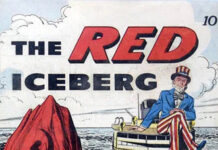
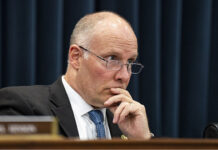


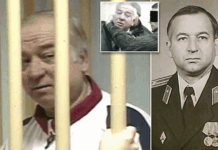
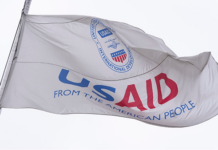
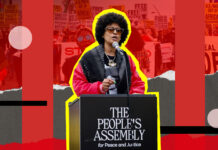

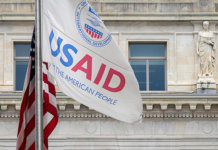

Thanks a bunch for sharing this with all folks you really recognize what you are talking approximately!
Bookmarked. Kindly additionally discuss with my website =).
We could have a hyperlink alternate agreement among us
[…] 2018-2019, the NED spent almost three million dollars in Belarus, which was targeted in a color revolution directed aga…, a close Russian ally who sustained considerable popular support because of the strength of his […]
[…] 2018-2019, the NED spent almost three million dollars in Belarus, which was targeted in a color revolution directed aga…, a close Russian ally who sustained considerable popular support because of the strength of his […]
[…] 2018-2019, the NED spent almost three million dollars in Belarus, which was targeted in a color revolution directed aga…, a close Russian ally who sustained considerable popular support because of the strength of his […]
[…] 2018-2019, the NED spent almost three million dollars in Belarus, which was targeted in a color revolution directed aga…, a close Russian ally who sustained considerable popular support because of the strength of his […]
[…] 2018-2019, the NED spent almost three million dollars in Belarus, which was targeted in a color revolution directed aga…, a close Russian ally who sustained considerable popular support because of the strength of his […]
Since the writer himself is a member of the American Media, he should rephrase his comment about the American Media being biased. He should just say that he feels that Reuters, CNN and New York Times in his opinion wrote biased reports on the situation.